Discussion on case conceptualization.
Assignment Overview:
For this assignment, you will be picking a hypothetical client that you believe demonstrates significant psychopathology, followed by formulating a case conceptualization. A case conceptualization includes a diagnosis, a discussion about how their pathology developed (i.e., etiology), and also a brief treatment recommendation. You may choose your client to be based on either a fictitious character (that exists in a book, movie, television show, etc.) or notable public figure; please do not complete this assignment based off of yourself or someone that you personally know. If you choose a fictional character, it could be a character from a book, video game, television show, or movie; do not make up a fictional character yourself. If you choose a public figure, it could be a famous athlete, politician, historical figure, or celebrity. Whomever you choose for this assignment, it is important that you have access to enough relevant information in order to make an informed diagnosis, as well as when making claims about the etiology of their pathology (i.e., completing the case conceptualization portion of the assignment). Discussion about how their pathology developed should be based off of theories discussed in class, as should your treatment recommendations.
Step-by-step instructions:
Describe the client:
Case conceptualizations typically begin with a brief client description that focuses on details relevant to their pathology. Important information can include the client’s age, gender, ethnicity, and socio-economic status. It also includes a brief description of their presenting problems, i.e., symptoms. For example, if this person demonstrates significant depressive symptomatology, this introduction to the client should list examples of each relevant symptom. In other words, you should substantiate your diagnosis by providing explicit examples that demonstrate each required criterion. Make a diagnosis based off these details. If you are missing a specific piece of information that is required for the diagnosis, state that this important information is unknown and would be required to make the formal diagnosis.
How did the pathology develop?
The next portion of the case conceptualization should discuss likely hypotheses about how their pathology developed, as well as how it is maintained. Use relevant details about the client to inform your hypotheses, and base these hypotheses off of theories of etiology discussed in class. You can support your possible causal mechanism(s) by also detailing risk factors that might have been present in the person’s life prior to, or during, the development the disorder. Again – there are many possible risk factors for each disorder listed in the class notes and readings, so draw your hypotheses from the course content. If there is a possible causal mechanism or risk factor for your hypothetical client’s pathology that was not covered in class, it is extremely important that you provide a sound basis for your conjecture. In other words, you need to back up your hypotheses with sound reasoning and/or prior research. Lastly, be sure to discuss why this person continues to have said disorder. Many of our discussed theories of etiology (presented in class and from the readings) focus on possible maintaining factors for psychopathology. Consider these theories and include if you think they are relevant for your client and their diagnosis.
Treatment recommendations:
Finally, briefly construct a treatment recommendation. Choose you course of treatment based off of evidence; in other words, when you discuss your recommendation, be sure to state whether there is any evidence suggesting that this course will be effective. Also, be sure to discuss why the treatment might be effective for your particular client. For example, if your client has many possible distorted thoughts that are likely contributing to their psychopathology, then you might choose Cognitive Therapy as an empirically supported form of treatment because it specifically targets maladaptive thoughts. Be sure to clearly state your reasoning, tying the treatment to your casual mechanisms. Doing so will provide more support for your treatment of choice. Also discuss how you plan on tracking your client’s progress through treatment (e.g., self-report measures targeting a specific aspect of their pathology). Lastly, if you think there are characteristics about the client that might make treatment go especially smoothly or poorly, be sure to denote how these strengths or weaknesses might get in the way or, or aid, treatment progress. These types of predictions are a good way to finish up your case conceptualization and treatment plan report.
Suggestion for Case Conceptualization Assignment Structure:
I. Introductory paragraph(s) on client details and diagnosis.
II. Etiology of their pathology – hypothesize how it began and how it is maintained. Refer to etiology materials presented in class/book to make a strong argument.
III. Recommend treatment course. Suggest a treatment, be sure it is empirically supported (and say so in your report), and then describe how it would work. Tie the components of the treatment to the etiological argument you made in Section II. Make predictions about how you expect treatment to go. List areas where you think the client might struggle (and why), as well as strengths about the client that might aid them in being successful with therapy

word limit: 878
